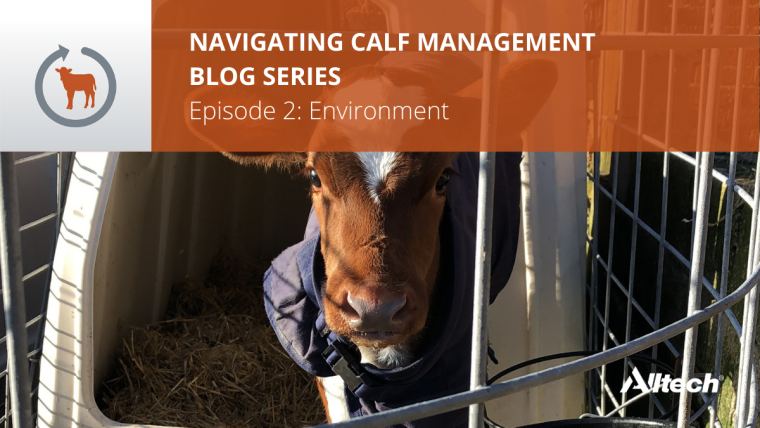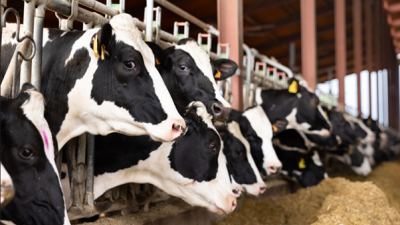Powering dairy calf development through the environment

This is the second episode of our ‘Navigating Calf Management’ blog series designed to help UK dairy producers lay early foundations for long and productive lifecycles. This important and complex topic has been broken down into four areas, including:
Episode 1: Colostrum
Episode 2: Environment
Episode 3: Weaning
Episode 4: Calving
Having looked at the importance of colostrum management in the first episode, we now look at how to manage calf housing to help maximise the utilisation of that nourishment on your dairy farm.
Newly born calves need an optimal environment to conserve their nutrients for growth and development, rather than fighting off environmental challenges. This simple “nutrition + environment” calf rearing formula during the first 12–14 weeks of life will give your dairy replacements the best chance at great milk production in later life. For the more immediate benefit, optimising nutrition and environment will help fight against calf disease, weight loss and conditions that can cost you precious life and time.
The 5 checkpoints that dairy farmers must cross off to optimise the environment of replacement heifers and calves are:
1. Keep them separate to start with
Although cows are social creatures, it is best to house new-born calves in individual pens or calf hutches until they are at least 10 days old and when they are healthy, eating and drinking well. After this period, they can be put into group housing with similar-aged calves, staying in these groups throughout the weaning process to reduce stress.
2. Keep them well-ventilated
Poor ventilation will increase a calf’s exposure to moisture, animal odours and gasses that can cause respiratory illnesses such as pneumonia. Furthermore, moisture produced from feed, urine and respiration, if not removed by ventilation, creates damp and humid conditions in which certain bacteria and viruses can thrive.
There are several housing systems for calves, be that indoors, outside in pods or individual hutches. However, in every housing system, it is essential to ensure they are clean and well-ventilated, with adequate lighting and space.
If you can smell ammonia, see visual condensation, observe a lot of cobwebs or notice the calves’ coats are slightly damp, your calves are not receiving adequate ventilation. Windows, fans and inlets around the ceiling perimeter allow the warm, humid air to escape and be replaced by cooler, fresh air entering above the calf. While the provision of fresh and clean air is essential, so too is avoiding under-draughts at calf level, so ensure adequate bedding and remove any low-level drafts (i.e., under gates).
Fresh air is critical to calf health — and it is free!
3. Keep them clean and dry
Calves spend over 80% of their time lying down. The quality and amount of bedding material are extremely important in managing heat loss via conduction from lying on cold floors.
Straw bedding should be deep enough that when a calf lies down, you cannot see her legs. This is called a “nesting depth” and should always be at least 15 cm deep and dry. Calves require up to 20 kg/head/week of straw bedding to maintain dry conditions on concrete floors. Raised slatted floors are 10 kg/head/week.
The bedding should always be dry enough to allow you to kneel in the pen for one minute without your knees getting wet. This ensures that the calves always have a comfortable and dry lying environment that will minimise the spread of disease.
Deep straw bedding is the gold standard for insulation; however, other bedding can be used in the summer, such as woodchip or shavings. When selecting bedding materials, it is important to avoid using dusty bedding where possible, as it can cause respiratory problems.
4a. Keep them warm when temperatures drop below 15ºC
Temperatures below 15°C [Lower Critical Temperature (LCT)] will cause a calf to re-prioritise nourishment to stay warm via shivering or growing a longer coat. For calves at 0–3 weeks, their LCT is 10–15°C. For calves over 3 weeks, their LCT is 5–10°C.
First, calf feeding needs to be increased to meet this extra energy requirement and maintain growth and development. Aim to feed an extra 50 g of milk replacer or an extra 0.33 litres of whole milk for each 5°C drop from 15°C. The interval between calf feeds should not exceed 12 hours, especially during the colder months, so consider spreading the calves’ feeds to three times a day. Calf concentrate should contain a minimum of 18% protein.
Second, consider using calf jackets to help keep calves warm, dry and healthy. Take care, however, that they do not overheat when temperatures vary between night and day in the spring months. Feel their ears and under their jackets to check they are at a broadly comfortable temperature and adjust their rugging accordingly.
4b. Keep them cool when temperatures rise above 25ºC
Temperatures above 25°C [Upper Critical Temperature (UCT)] will cause heat stress in calves. The calf will redivert her energy to maintain core body temperature via sweating, standing and panting. Calves will also eat and drink less.
- Aim to increase airflow in the building above calf height, with fans or opening doors and windows.
- For calves housed outside, provide shade in the pens, so they have space outside, away from direct sunlight.
- If calves are housed together, reducing stocking rates can help reduce heat stress.
- Provide extra energy by increasing the volume of milk or the concentration of milk powder.
- Feed concentrate little and often at both ends of the day to ensure freshness.
- Provide fresh drinking water out of direct sunlight twice a day.
- Avoid keeping or using water troughs and buckets over bedding so as to stop bedding becoming wet and providing a warm, moist environment perfect for bacterial growth.
As ever, all milk feeding equipment and water buckets must be cleaned twice a day. Bacteria thrive in warm, damp conditions. This, paired with lower immunity in heat-stressed calves, is a perfect storm for illness and disease.
5. Keep tabs on everything
Temperature levels below or above the optimal 10–20ºC and humidity levels below or above the optimal 65–75% will leave calves with less energy available for growth, development and immunity.
Practice monitoring temperature in the calf shed every time you enter the building, using a thermometer at the calves’ head height. To take it a step further, you can get temperature, humidity and wind speed sensors that send alerts to your phone when it is below a set temperature.
By raising calves with good ventilation, bedding and warmth, they stand the best chance of developing and growing without any setbacks. If you have any questions or require any personalised advice, please contact your local advisor or call our InTouch Hub on 0800 587 3297.














